The Ubiquitous Mercury & Demonology
“Science is magic that works.”
— Kurt Vonnegut (Cat’s Cradle)
Part I: The Ubiquitous Mercury
The Eighth Sephirah is Hod, yet another home of Mercury, who has already shown up several times in our discussion of the Tree of Life (most notably Kether, Path 12, Path 17, and Path 20). Let’s discuss him in even more detail before we turn to other matters germane to Hod, such as the rational mind, the tarot, and daemons.
Mercury, known as Hermes to the Greeks, is especially beloved by magicians. More than any other god he has hands all over the place. He is the original jack-of-all trades and has so many varying attributes that it is no wonder the word “mercurial” is derived from his name.
Here are some of Mercury’s many functions, accomplishments, and titles:
- He is the god of merchants—also thieves, gamblers, and liars.
- He protects travelers on the road.
- He graces orators, writers, and poets with wit.
- He is the god of magick, invention, and good luck.
- He is the patron god of boundaries and those who cross them.
- He protects shepherds, miscreants, harlots, and old crones.
- He is athletic and protects runners from injury.
- As an infant he created the lyre.
- He invented fire.
- He is a trickster.
- As psychopompos he helps the dead find their way to the Underworld.
- Able to travel swiftly from place to place, he delivers messages from Olympus to the mortal world, and messages between
the gods. - He is closely related to the Germanic Wotan (or Odin) and the Egyptian Thoth.
- The Homeric Hymns call him a “giver of grace, guide, and giver of good things” as well as being “of many shifts, blandly cunning, a robber, a cattle driver, a bringer of dreams, a watcher by night, a thief at the gates, one who was soon to show forth wonderful deeds among the deathless gods.”114
His symbol, which you should now be quite familiar with, is a representation of Mercury wearing his winged-hat (a petasus), and his winged-shoes (talaria): ![]() . Also his petasus could be considered “horns,” which in magick are not considered evil, but rather as a connection to divinity.
. Also his petasus could be considered “horns,” which in magick are not considered evil, but rather as a connection to divinity.
There is no disharmony amid all Mercury’s many diverse abilities and functions; he is able to perform all his duties with finesse and alacrity. Part of his very essence is to be able to change roles quickly and completely when the necessity arises.
The Caduceus
Mercury carries a staff called the caduceus, which is meant to be a pictorial representation of all he stands for, including his job as protector to merchants, thieves, and liars.
It is interesting that the medical association has erroneously taken the caduceus as their own, which has nothing to do with medicine. The symbol that should be associated with medicine is actually the Staff of Asclepius, which has only a single snake and no wings.


The Wand of Hermes (the “caduceus”)
and the Staff of Asclepius


The Wand of Hermes (the “caduceus”)
and the Staff of Asclepius
Along with his caduceus, Mercury also carries a money bag. As master of magick and the spiritual world, he still firmly understands the concerns of the material plane, and is quick to exploit its laws for his own advantage.
Mercury in Magick
Mercury is the central god of magick, able to accomplish almost anything with his ingenuity.
Crowley rightly associated Mercury, in his trickster form, as the final veil before the pure experience of God. He is the last deception, beyond which nothing can be said because words are lies, an abomination against the one truth. Mercury leads us, protects us, but he also tests us—sometimes severely.
Mercury is not only our friend, our ally, and our greatest enemy—he is our True Self, changeable, yet unchanging, fast as light, yet patient as eternity.
Mercury rules over magick, but true to his varied nature, he is also lord of our rational mind, which we will discuss next.
Part II: The Rational Side of Magick
“My atheism, like that of Spinoza, is true piety towards the universe and denies only gods fashioned by men in their own image to be servants of their human interests.”—George Santayana
Logic, rational thought, scientific rigor—all these things are an important part of our lives, both individually and collectively as a race. Nothing in magick should negate physics, biology, or any science whatsoever. High magick is the realm of deep psychology, far beyond clinical standards.
Beyond Rational Thought
“Logic will get you from A to B. Imagination will take you everywhere.”—Albert Einstein
On the Tree of Life, the rational mind belongs to the Sphere of Hod. It is an important part of the Tree of Life and should not be ignored; however, it is just one Sephirah out of ten. It is not the most important, nor the most balanced. It is low on the Tree of Life and off-center to the side of Severity.
Do not make a god out of your rational mind. It is just one aspect of a balanced human organism. Some rational-minded people, often extremely intelligent and scientific, make this mistake. They hold up the rational mind as the pinnacle of mankind’s abilities, when in reality, logic and the rational mind are mistake-prone, flawed, and even dangerous.
The rational mind and so-called human logic have produced many scientific marvels, including sanitation, antibiotics, and the iPod. However, the rational mind and scientific rigor have also led us to create weapons so powerful they have the potential to wipe out our entire species. Is that really progress? Does that sound enlightened to you?
The rational mind goes around in circles. There can be no ultimate answer to what anything actually is—nothing is anything except in relationship to everything else. The rational mind is a dead end.
Even modern science reaches the extremities of the rational mind with concepts such as Heisenberg’s uncertainty principle (which says we cannot know the position of a particle and at the same time know its momentum) and “Schrödinger’s Cat.”
The “Schrödinger’s Cat” thought experiment is an imaginary scenario about a cat in a sealed box. In this scenario, the cat’s life is dependent on the state of a subatomic particle. According to quantum mechanics, that cat is both alive and dead at the same time—until we open the box; then it becomes one or the other. Does that sound “rational” or more like Zen?
Zen Buddhism, famous for odd little stories115 taught by “crazy” Zen monks, doesn’t intend to be silly any more than Schrödinger’s Cat is meant to be silly. Zen is about “shocking” statements or actions breaking down the rational mind and allowing intuition and enlightenment to shine in. Enlightenment is to experience reality directly, without words, thoughts, and “rationality” mucking it up.
In magick, specifically Qabalah, we have an advanced system for incorporating the rational with the “unknowable and irrational” aspects of the universe. Magick accepts rationality right along with “intuition,” and through work upon the Tree of Life, such as given in this book, we develop both, creating a more enlightened state than anything the rational mind alone has to offer.
Science vs. Religion
To me the acrimony and hatred that still exists between religion and science is absurd.
Nowadays the science vs. religion battleground is more specifically creationism vs. evolution, which is especially ridiculous. Why is it so hard for a creationist to believe that God “created” the universe through natural means such as millions of years of evolution? Why is it so hard for some scientists to accept there is an unknowable, miraculous quality to existence that, for lack of a better term, can be called “God”?
Albert Einstein said, “Science without religion is lame, religion without science is blind,”116 while Aleister Crowley’s motto for the A
A ![]() is: “The method of science, the aim of religion.” 117 It seems to me that the greatest scientist of the 20th century and the greatest magician of the 20th century are in complete agreement. We need the aspects of science and religion to survive and thrive as individuals and as a race.
is: “The method of science, the aim of religion.” 117 It seems to me that the greatest scientist of the 20th century and the greatest magician of the 20th century are in complete agreement. We need the aspects of science and religion to survive and thrive as individuals and as a race.
In magick, we do our best to harmonize spirituality with science.
What if I’m an atheist or an agnostic—
this magick stuff can’t possibly work for me, right?
Belief in anything specific is not required for the magick in this book to work, but if you constantly send negative and inhibitory messages to your subconscious, such as “this can’t possibly work” or “magick is fake,” you may very well overwhelm any good that can come of your rituals.
To escape that mental pitfall, all you have to accept is that the subconscious mind has access to abilities and powers that you do not. That’s it. If you can get into that mindset, you are good to go.
Thinking vs. Action
Another problem with the rational mind is that it encourages too much thinking and over analyzation. Too much thinking leads to inaction. Inaction leads to misery and depression.
Rodin’s Thinker, the famous bronze and marble statue of a man sitting and thinking with his chin resting on the back of his hand, ponders his situation thoroughly, but he doesn’t do anything! To me he looks miserable, reminding me of dreary, endless hours spent “in my head” instead of out making changes in my life.
Crowley’s The Book of the Law sums up this pitiable situation admirably: “If Will stops and cries Why, invoking Because, then Will stops & does nought … Also reason is a lie; for there is a factor infinite & unknown.”118
In action, we will find true meaning, true bliss. To make a “mistake” is no worry, as we will just readjust, recalibrate, and move on. We will have learned something, become wiser, and be better equipped to perform right action in the future.
Right action is simply the “intuition” of taking immediate and proper action in the appropriate moment. It is the uncanny ability to automatically make the right choice without thinking too hard about it. All our work with Qabalah and the Tree of Life is to help us develop this ability.
Part III: The Tarot and Divination
A Brief History of the Tarot
Europe got its hands on regular playing cards in the late 14th century from Egypt, which at this time was ruled by the powerful Mamluks, once slaves to Arab caliphs.
Within fifty or so years, tarot cards popped up in northern Italy. They had additional cards with allegorical illustrations on them. These decks were called carte da trionfi, i.e., “triumph cards.” In English, the Major Arcana are still often referred to simply as the “trumps.”
There is not much historical detail on how the tarot grew from simple playing cards into pictorial storehouses of occult knowledge. Most likely it was a gradual transition as Hermetic scholars, the same elite class that would have access to playing cards, learned of their usefulness in both organizing their thoughts and hiding often controversial mystical concepts from the profane (and those who would persecute them).
Today, the tarot is part and parcel of the occult world, considered not a game, but a “book of wisdom.”
Uses for the Tarot
Like Mercury himself, the tarot pops up with regularity throughout not only this book but throughout the occult world in general. There are almost limitless uses for the tarot, and ultimately no “right or wrong” way to use them. Here are a few of its more typical uses:
Use the Tarot For:
Meditation: They make an excellent focus for your concentration attempts.
Rituals: Use the tarot to enhance almost any type of ritual by selecting the card or cards that are most appropriate to your working.
Pathworking: Use your “imagination” to travel up and down the Tree of Life using tarot cards as your focus. (See Chapter 9 for more details on pathworking.)
Art and decoration: It’s a healthy thing to see your tarot around your office or home, reminding you of occult knowledge throughout your day.
Understanding the Tree of Life: Since the tarot is a nearly perfect representation of the Tree of Life, its allegorical and symbolic representations can make understanding Qabalah and the Tree of Life a lot easier.
What about the tarot as a divination tool?
For the most part, divination is overused; mainstream occultism relies on it far too much. Fortunetelling feeds the ego and induces hesitation and doubt instead of promoting action, energy, force, and success against any challenge that may arise. I’ve seen too many beginners get trapped obsessively worrying about the results of their tarot readings.
Your life is your masterpiece. A painter does not stop to consult an oracle to ask where his next stroke should go. You also should learn to move forward in life making choices as best you can, and let the chips fall where they may. In this way, you will develop genuine intuition, which requires no cards, no crystal balls, and no astrology.
That said, everything you learn in this book will go a long way to making you a great tarot reader if you should choose to go that road further into your magickal career. If you insist on doing tarot readings now, at least do them for others where you can learn to be completely passive and objective. It’s nearly impossible to learn tarot reading properly by doing readings on oneself as the ego will muck up the calm equanimity needed for accurate divination.
Part IV: Demonology
Demons. Few things capture the imagination of a magician as much as the idea of spiritual beings who will carry out the magician’s every whim or desire.
Many cultures throughout the millennia have had similar concepts of “lesser” deities who could be persuaded to help man with his life and his problems. The word “genie,” for example, comes from the Latin genius, which is a guardian or “tutelary” spirit.
Arabic and Islamic mythology have the concept of the djinn.119 The djinn are spiritual beings, lesser than angels, that can help or hinder man depending on their own nature as good or evil.
The root of the word demon itself comes from daemon (or dæmon), which is the Latinized form of the Greek (“daimôn”). Daimons in Greek were lesser divinities, or the souls of dead heroes. Originally, the Ancient Greeks had no concept of “evil” daemons, but as Christianity took hold, the concept of daemon slowly acquired the menacing and evil associations that the word “demon” has now. This sort of demon has become popular in movies beginning with The Exorcist in 1973. Needless to say, this sort of demon has nothing to do with the sorts of practical and useful daemons we use in magick. Therefore, I use the spelling daemon to refer to any spirit less than an angel, such as Goetic daemons instead of Goetic demons.
What is a “lesser” spirit?
A lesser spirit is anything lesser, or lower, than an angelic force. They are generally used for practical concerns.
In magick, there is a divide between the “angelic” forces and “daemonic” forces, which is essentially a measure of how close they are to the material plane.
Angelic forces are those closely related to God. They are spiritualized and tend to naturally inspire us and lift us closer to Godhead. Daemons are “lower,” “lesser,” or “blacker” because they exist closer to the material plane, hence their great power over it. However, being so close to earth and man, the heaviest of the planes, daemons are also more stubborn and likely to lead us astray than the angelic forces, hence their reputation as potentially negative or “evil.”
So why not just use angelic forces?
In medieval magick, things were extremely hierarchical. First, you invoked God and angelic names, and then you used their power to command the daemons. It was not considered an evil act to work with daemons as they were to submit to your Will, and your Will is considered to be an extension of divinity.
To ask an angelic force to do something as mundane as pay off your mortgage or get you a mistress would have been considered insulting to the angel. Instead, the dirty work of solving day-to-day needs and problems is left to the daemons.
Are angels and daemons real?
The modern view of magick tends to consider angels and daemons to be real in a psychological sense. They exist in your psyche and therefore when contacted, they can produce actual changes in your life. Whether you treat angels or daemons as real “entities” that exist separately from humankind or merely a function of your subconscious is entirely up to you.
In magick we treat them as “real” entities, because it makes good “drama” and drama in rituals goes a long way to producing tangible, practical results.
Grimoires
In magick, a grimoire is any book that lists daemons, angels, or spirits and describes how to invoke them.
For example, the Goetia, by far the most popular “phonebook” of demons, is a mixed bag, containing an assortment of traditional gods from other cultures, daemons, local deities, and dozens of spirits that no one has any idea of where they came from.
In the follow sections I will introduce all the major grimoires.120 I have bolded the first mention of each grimoire for ease of reference.
The Goetia
The Goetia121 is part of a longer work called The Lesser Key of Solomon,122 which is a collection of medieval grimoires attributed metaphorically to King Solomon.
The first section is the Ars Goetia. This is the legendary Goetia, a book of 72 daemons and their sigils. A classic in every sense, it’s the standard whereby other grimoires are judged. It was an early favorite of Crowley’s and his version is still the most popular one to this day.
Other versions are available, including the Pseudomonarchia Daemonum, originally an Appendix to Johann Weyer’s De praestigiis daemonum (1577). This version is notable for being the earliest publication of the spirits named in the Goetia, however there are no sigils in the Pseudomonarchia Daemonum. It is also lacking four daemons: Vassago, Seere, Dantalion, and Andromalius. One daemon from Pseudomonarchia Daemonum is missing from the Goetia: Pruflas.
The Mathers/Crowley version of the Goetia is subtitled “The Lesser Key of Solomon the King,” but this is erroneous as it only contains the first part of the Lesser Key of Solomon, the Goetia proper. The actual Lesser Key of Solomon has four more parts:
Theurgia-Goetia—This section contains conjurations for thirty-two spirits relating to the cardinal directions, some good and some evil. Oddly enough, however, the history of this section isn’t about the occult at all. The Theurgia-Goetia is actually based on a work by German abbot and occultist Johannes Trithemius called Steganographia.123
Ars Paulina—A method for invoking the “Angels of the Hours of the Day and Night.” Like Theurgia-Goetia, this is based on spirits from Steganographia.
Ars Almadel—Tells how to make the Almadel, which is a wax tablet with protective symbols drawn on it. It teaches how to call upon the angels of the four “Altitudes.”
Ars Notoria— A medieval book of prayers and invocations.
There is also the Greater Key of Solomon. While there are no spirits to invoke, there are “Holy Pentacles” for each of the seven traditional planets. They can be useful in talismanic work, either as inspiration for your own designs or verbatim.
Other Grimoires
Arbatel de magia veterum,124 or simply the Arbatel of Magic, is a Latin treatise on magick published in Switzerland (1575). This book is the source for the Olympic Spirit we used in Chapter 4.
John Dee’s Enochian125 magick is a solid system of working with angels and elemental spirits, but it has its own complex methodology and is outside the scope of this book. A straightforward approach to Enochian is clearly outlined in the Enochian World of Aleister Crowley: Enochian Sex Magick by Crowley, Duquette, and Hyatt. Using what’s given there, or any other good source on Enochian, will allow you to easily plug Enochian into the magickal framework you learn here. Bits of the Enochian language are also part and parcel of many Golden Dawn and Thelemic rituals.
Another of John Dee’s grimoires, Heptarchia Mystica, was inspired by the Ars Paulina. He may not have realized its underlying steganography at that point, however.
There is a small treatise floating around called The Little Book of Black Venus, which has a sigil for spirits that you can invoke using the methods in this book. This book purports to be written by John Dee, though that is most likely not the case, being simply attributed to him for the sake of credibility. It seems to have been inspired by the Arbatel of Magic as the sigil designs have strong similarities to each other.
The Book of Abramelin126 is one of the most famous and talked about books in magick. It is also one of the least performed because of its long and arduous process of meeting your HGA, which is to be undertaken before any of the practical magick can be performed.127 This book contains dozens of magick “squares,” which purport to grant all the usual goodies of wealth, love, and abundance that grimoires usually do.
Two other well-known grimoires are The Black Pullet (18th century), which reads almost like a fairy tale, and Grimoirium Verum (18th century), full of generally absurd requirements and claims. Many grimoires claim they are much older than they really are. These two are no exception.
What about the Necronomicon?
While there are several versions of the Necronomicon now available, the most popular and infamous is the Necronomicon by Simon, first published in 1977. However, the original “Necronomicon” is an invention of author H.P. Lovecraft, described in his stories as a forbidden and evil book scribed by Abdul Alhazred, also known as the “Mad Arab,” in Damascus, 730 A.D.
The Simon Necronomicon is rather notorious in the occult community. It is clearly a hoax, but that hasn’t stopped people from using it, and claiming results. It’s also the book I’ve heard the most horror stories about. Most of those people were beginners plunging into their first grimoire so that might have something to do with it. For whatever reason, this book tends to draw in newbies and then freak them out if they actually start to practice it.
Though Simon’s Necronomicon is based more on Sumerian mythology than H. P. Lovecraft, many practitioners mix it with the written works of H. P. Lovecraft. This mishmash of ancient and sinister energies has created a psychologically resonant system of magick.
The main danger I see in working with this type of magick is taking on its overarching belief system, that is to say the mythos of H.P. Lovecraft. All his stories end with madness, suicide, murder, or worse. They are some of my favorite horror stories, but they generally aren’t the type of energy I’m looking to invoke into my life.
If you must use Necronomicon magick and are having problems “banishing” or getting back to reality, then use a powerful solar ritual (i.e., use Tiphareth or Path 30 with the Tree of Life Ritual given in Chapter 10). However, think twice before taking on this belief system for your magick. I don’t recommend H. P. Lovecraft-based rituals unless you are an advanced student of magick.
Servitors
Chaos magicians create their own daemons called “servitors.” Chaos magick is completely open-ended and evolves constantly so there is no single prescribed ways to make servitors. Research it online, because that’s always the most up-to-date place to find what Chaotes are up to. I give detailed instructions on how to make a servitor in Chapter 10.
Servitors function just like regular daemons but with none of the baggage. You define them, give them lots of energy, and let them go like any other type of magick. These are a little more advanced in some ways. We trust the subconscious mind to understand our structures the same way a computer operating system understands a program.
You may consider servitors and daemons both as “sub-processes” running in the background of your mind, quietly carrying out their tasks as best as possible given your personality and current life situation.
Building a Relationship With a Daemon
One thing that makes working with daemons different than working with talismans is that daemons become more powerful if you build a relationship with them over multiple workings. A “friendship” may develop between you and the daemon that may last for months, years, or a lifetime.
Only the medieval-minded make demonology into an adversarial arrangement. One need not threaten and cajole a daemon, nor should a magician have to worry about the daemon hurting them in some way. Instead, treat the daemon as a latent aspect of your own psyche whose job is to help you.
You may never actually see or hear daemons in a perfectly clear fashion, but you must learn to sense them in some way. You can expect their communications to be subtle. They might speak in omens or through “coincidences.”
Ultimately, the proof is in the pudding. Some people can see or hear the daemons quite visibly and aurally, but the daemons never deliver anything as promised. If over a reasonable amount of time, you don’t feel noticeable results have been made on the material plane, then you should forgo working with that daemon anymore. We are concerned with results more than “astral communication,” which can just be delusion. Physical results are the only proof a magician has that his or her magick is working. Anything else is just a mental “jerk off.”
Familiars
As far as this book is concerned, a “familiar” spirit is one you work with regularly and intend to “keep” for an extended period of time. If you just invoke a spirit once that is not a familiar. But if you work with it regularly, sending it energy, communicating with it over months or years, it becomes a familiar.
I have had a familiar for many years. Her name is Izabael and my experiences with this spirit have affected my life and my magick deeply, not always positively, but always intensely.
My Life With Izabael
A description of my life with Izabael will help illustrate how a deep and lasting relationship can be built up with a spirit. It’s not always been a smooth road with Izabael, but ultimately she has been a blessing and has drastically changed the course of my life on numerous occasions.
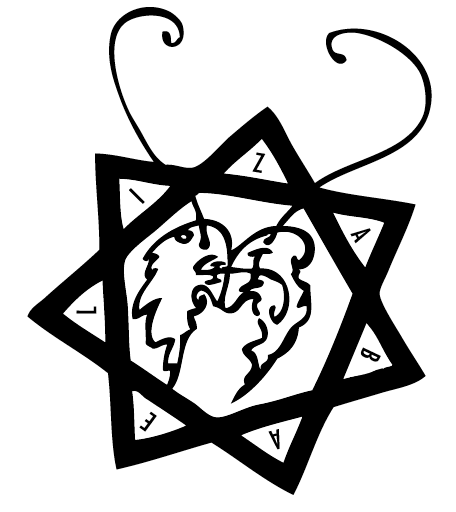
Izabael’s sigil

Izabael’s sigil
My personal example will also illustrate it’s not always a clear line between a servitor and a daemon, as all daemons can be quite different depending on who invokes them; they also tend to change or evolve with time.
My experience also illustrates that imagination can affect reality, even without magick ritual. I had no idea that the things I imagined for my art would come true in my life. Never underestimate the power of imagination to change lives.
Once again I also point out it doesn’t matter if daemons are real in a literal sense—they may be little more than “imaginary” friends—but if that is so then “imaginary friends” are an incredible tool for transformation.
A Brief History of the Daemon Izabael
1996—Worked with the 70th Goetic spirit Seere (also Sear or Seir) in an intense magickal working under the influence of LSD. The method I used, minus the LSD, is similar to the method I will give in this chapter. During this invocation, however, I worked with several other daemons at the same time so the results may have been comingled. I had just finished college at the time, and was looking for help on several levels. A new love and some sort of income were high priorities. Soon after, I stopped working with magick for awhile. I moved to a new city, and was undergoing quite a bit of soul searching (it was the first time I was completely alone in a new city for one thing). The money thing worked itself out temporarily and there were a couple of brief romances. For the most part, I forgot about and gave up on daemons.
1997—Idea for character “Isabelle” came to me. The concept was that she was both an ancient daemon and a modern artificial intelligence.
1998—I wrote the first draft of a novel which starred the character “Isabelle.” It was autobiography veiled in a sci-fi milieu. The novel ends with Izabael, the formless artificial intelligence, finally getting a body.
1999—I moved to Los Angeles because it had long been a goal of mine, and to be with a new girlfriend—my first “Babalon.”128 She was not the result of a daemon working, but rather the result of a solo sex magick ritual I did a few months earlier. I will describe that type of ritual in the next chapter.
2000—I created a servitor in the tradition of chaos magick. This was when I divined the appropriate spelling of “Izabael,” which worked for me on a number of levels, both personally and Qabalistically.129 I did not have the proper sigil for Izabael at this point, however. It was something I struggled with and changed quite often, never quite satisfied with the look of it.
2001 through 2003—I did various rituals with Izabael during this time. Her sigil was still evolving, and by this time Izabael caused “strange occurrences”130 both to me and my Babalon. I felt I could sense Izabael through odd “coincidences,” which had specific and special meaning to myself only. My Babalon and I worked with the spirit on a few different occasions. One early working, with her as the oracle and me using my magickal name of Pamphage, went like this:
Pamphage: So, she’s sleeping? [Referring to Izabael]
Oracle: She must be tired from ruining my dinner.131
Pamphage: What does she look like?
Oracle: Well, for one thing, you need to get her some pajamas because she is sleeping in her clothes.
Pamphage: What is she wearing?
Oracle: It’s hard to tell, looks like some black thing … like leggings or something and a black top … all black though, definitely. Cool shoes. Backless slip-ons, flats.
Pamphage: What else?
Oracle: I think she has a weird belt on, but I can’t tell. The leggings are shortish, capri-length, mid-calved. I can’t tell if the top has short sleeves or long. The whole thing is very formfitting and she has a nice body.
Pamphage: How big is she?
Oracle: Little. She could stand on my hand. Six inches. Maybe.
Pamphage: Is she in a particular place?
Oracle: I can’t tell exactly, but I keep getting the beach or the sea like she sleeps in a shell or something, but I think that’s coming from somewhere else in my mind. Maybe in a cave by the ocean, something protected, not like the regular beach, not all out there on the sand. That’s sort of far away, but I guess she can travel fast.
Summer of 2004—By this time I was no longer with the aforementioned Babalon. I started work with Seere again, but this time on Salvia divinorum. My experience of daemons on Salvia is very different than at any other time. They feel/look like vibrating patterns of energy that are part of the bigger, more complex energy that permeates the universe. During one working, Seere revealed that indeed he had been the inspiration for Izabael (and “Isabelle”) the entire time (as well as confiding he had been the inspiration for Shakespeare’s Ariel from The Tempest, which sounds really cool, but daemons say a lot of things to boost their reputation with the magician.) Seere revealed the true nature of Izabael’s sigil, by taking over my hand while I drew the sigil.
He also took control of my hand to write “Izabael is Seere” in my copy of the Goetia.
Two versions of Seere’s sigil:




You’ll note Izabael’s sigil is similar to his own, but is more “butterfly” in appearance. I later added the septagram to Izabael’s sigil to give her tighter focus and bind her even more firmly to Babalon and all the other cool things that seven stands for.
2005—I met a strange, lovely girl on the streets of Hollywood. She needed a ride so I gave her one. We married within a week. Though a novice, she was a natural with magick. Within months she was initiated by me and tattooed with the sigil of Izabael.
2007—After two years of magickal training, my new Babalon legally changed her name to Izabael as the final seal of invoking Izabael the spirit into her. After my wife’s name change to Izabael, she became more wild and less focused. She used to look up to Izabael the spirit for guidance, but now she seemed to struggle with her identity.
2008—Less than a year after the name change, Izabael and I split up. She had been working (practically worshipping) her own daemon by this point, Paimon (also from the Goetia.) She ran off with the “result.”
2009—At this point, Izabael is pretty much off on her own and does her own thing. It’s hard for me to say where Izabael the spirit, and Izabael the woman begins or ends anymore. While I still feel I have some connection to Izabael as a bodiless spirit, I also am acutely aware of her new independence. Things have definitely not been the same since she found that body she was always after.
I hope my timeline has illustrated the open-ended nature of spirit working. They tend to take on a life of their own, and the more time you put in, the more seriously you take them, the better they work and the more powerful they become.
Grimoire Smimoire
Trying to follow the original instructions in most grimoires is nearly impossible. The tasks are often absurd to modern eyes, important sections are sometimes missing or illegible, and many of the items called for are difficult or expensive to obtain.
I will, however, say the “barbarous names of evocation” given in the Goetia are still quite useful and trance inducing. I reproduce the least adversarial of them for the summoning ritual given later in this chapter.
Instead of trying to follow the instructions in the Goetia, we will instead plug the daemons into the structure you have learned here. That will keep you safe. The main danger of demonology is self-delusion. That’s why I stress material plane results over any other form of “proof,” visual or otherwise.
Patience is required. It took years to feel the full effects of my early daemon workings. The daemons have repaid my efforts tenfold, sometimes a thousand fold, though admittedly some daemons can really exacerbate bad habits, so be vigilant.
Remember, of all the angels and all the daemons of the world, there is only one spirit that deserves your ultimate devotion.
Your HGA as a Daemon
Your Holy Guardian Angel is the highest and most powerful “daemon” you can contact. It is the only spirit that can never lead you astray. It is the only daemon or spirit that is available for contact at any time and any place. You need not know the name of your HGA. You need not do complicated rituals to invoke your higher self (though for some people, this helps). Your higher self is there in the calm quietude of pure being. As discussed in Chapter 6, whenever you are in the moment, feeling that “good feeling” over just being alive, you are in communion with your HGA.
At the beginning of Crowley’s Goetia is the Bornless Ritual. This was not in the original Ars Goetia, but Crowley inserted this ritual as a means to invoke your HGA before working with the daemons. He did this because you are much less prone to delusion or other dangers if you make a connection with your higher self before starting a daemonic working. The Equilibrating Ritual of the Pentagram is enough for practical demonology, but should you feel like adding the Bornless Ritual to the ritual given in this chapter, you may very well do so.
Why invoke Izabael?
She is a straightforward and goodly spirit. She connects us to our higher self and leads us to the loftiest goals through even the basest of our pleasures.
Izabael can be summoned and used the same way any other Goetic daemon can.
She is light, airy, and helpful, almost like an angelic force. She tends to “come and go” and when she comes, she usually brings many changes all of a sudden.
Qabalistically she has influences from Mercury and Venus. She makes her home in Tiphareth and reaches the Supernals through Path 17, the path of Zain. This path describes her energy almost perfectly and therefore both seven (the number of letters in her name) and seventeen are sacred numbers to her, as well as the number “56,” which her name adds to by Gematria.
The Triangle of Art
The “triangle of art” is a triangle with a circle inscribed within it, traditionally used to conjure spirits. This is drawn, painted, or otherwise constructed for use within the temple, intended to provide a “protected space” outside the magick circle, into which spirits are forced to appear. Usually this triangle is surrounded by sacred names, and in the center is the sigil of the daemon to be invoked, or a black scrying mirror.
Though perhaps shocking to purists, I don’t use a triangle of art. In my years of streamlining magick down to the essentials, I feel it is not only unnecessary, but can create a mental block between you and the spirit you are trying to invoke. It hearkens back to the medieval mentality that these daemons are adversarial and must be forced or confined into a small, safe place.
If you follow the instructions in this book, then the following ritual is entirely safe as it is.132 However, if you have used a triangle of art in the past, or would feel better doing so, you may of course proceed as you see fit.
Ritual to Invoke a Goetic Daemon
This ritual is tailored to invoke Izabael; however, it is also meant as a template to easily create your own ritual to invoke any daemon, especially those from the Goetia.
I. Prepare a suitable basis for the daemon
I find that silver dollars work well when painted with a particular daemon's sigil. You can also make their sigil out of wood or a particular metal appropriate to whatever daemon you are invoking.
Izabael prefers a pretty bottle or open sea shells, but you may start with painted poster board, or something similar, until your initial successes give you more confidence with the spirit and you really want to take the time to do the sigil up right.
Once you have the sigil drawn or painted on some sort of material basis, you can prepare your temple as you see fit.
II. Perform the Equilibrating Ritual of the Pentagram
You should be completely comfortable with this ritual by now. If not, you are not quite ready for daemon invocation.
III. Invoke an appropriate element, planet, or Sephirah
This would be according to the personality of the daemon if you know it, or simply use a specific part of the Tree of Life cognate with your desire, such as Netzach for a lust daemon.
You may use the Tree of Life ritual given in Chapter 10 to accomplish this, or come up with your own method. I’m leaving the details to the student’s own ingenuity for this ritual. If you feel you are ready to work with spirits beyond Izabael, then you should also be at the level where you feel comfortable about constructing your own rituals, or at least customizing the ones given in this book.
In our example, Izabael is decidedly airy so we will invoke air using a traditional Golden Dawn Enochian ritual as given in Crowley’s Liber Chanokh. There is a specific ritual assigned to each of the four elements.133 The one for air is technically known as “Opening of the Temple in the Grade of 2°=9![]() .”
.”
Open the Temple in the Element of Air
1. Stand in the Sign of Shu,134 i.e., spread out your hands above your head as if you were supporting the sky.
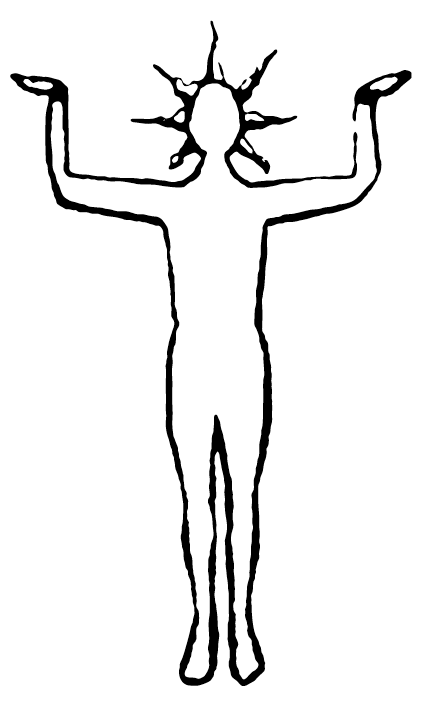

2. Ring bell or knock. Then say in a powerful voice:
“Let us adore the Lord and King of Air!
Shaddai El Chai! Almighty and ever-living
One, be Thy Name ever magnified in
the Life of All. Amen!”
3. Stand in the Sign of Shu once again, saying:
“And Elohim said: Let us make Adam in our own image,
after our likeness, and let them have dominion
over the fowls of the air.”
4. Draw the Air invoking pentagram:
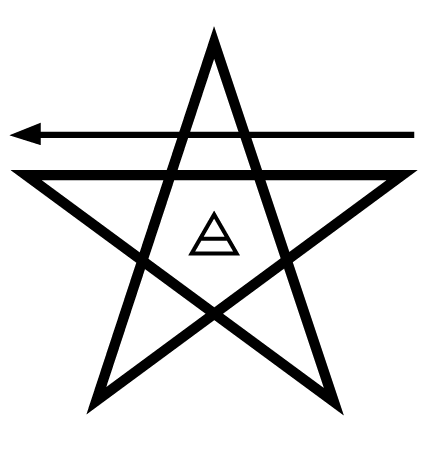

5. Say with conviction: “In the Names Yod Heh Vav Heh and of Shaddai El Chai, Spirits of Air, adore your Creator!”
6. With finger or Air dagger, make the sign of Aquarius ( ![]() ).
).
7. Hold dagger up, or point finger into the air, and say: “In the Name of Raphael and in the Sign of the Man, Spirits of Air, adore your Creator!”
8. Draw a cross in the air before you and say, “In the Names and Letters of the Great Eastern Quadrangle, Spirits of Air, adore your Creator!”
9. Hold dagger up, or point finger into the air, and say: “In the Three Great Secret Names of God, ORO IBAHA AOZODPEH that are borne upon the Banners of the East, Spirits of Air, adore your Creator!”
10. Point your finger or dagger as high into the air as you possibly can and say:
“In the Name of BATAIVAHA,
Great King of the East, Spirits of Air, adore your Creator!
In the Name of SHADDAI AL CHAI,
I declare that the Spirits of Air have been duly invoked.”
11. Ring bell or knock nine times.
IV. Recite the Enochian invocation for Air
MICAMA! goho Pe-IAD! Zodir com-selahe azodien biabe os-lon-dohe.
Norezodacahisa otahila Gigipahe; vaunud-el-cahisa ta-pu-ime qo-mos-pelehe telocahe; qui-i-inu toltoregi cahisa i cahisji em ozodien; dasata beregida od torezodul!
Ili e-Ol balazodareji, od aala tahilanu-os netaabe: daluga vaomesareji elonusa cape-mi-ali vaoresa cala homila cocasabe fafenu izodizodope, od miinoagi de ginetaabe: vaunu na-na-e-el panupire malpireji caosaji. Pilada noanu vaunalahe balata od-vaoan.
Do-o-i-ape MADA: goholore, gohus, amiranu! Micama! Yehusozod ca-ca-com, od do-o-a-inu noari micaolazoda a-ai-om. Casarameji gohia: Zodacare!
Vaunigilaji! od im-ua-mar pugo pelapel Ananael Qo-a-an.
V. Goetic Invocation135
Chant:
“I DO invocate and conjure thee, O Spirit IZABAEL; and being with power armed from the SUPREME MAJESTY, I do strongly command thee, by BERALANENSIS, BALDACHIENSIS, PAUMACHIA, and APOLOGIAE SEDES; by the most Powerful Princes, Genii, Liachidee, and Ministers of the Tartarean Abode; and by the Chief Prince of the Seat of Apologia in the Ninth Legion, I do invoke thee, and by invocating conjure thee. And being armed with power from the SUPREME MAJESTY, I do strongly command thee, by Him Who spake and it was done, and unto whom all creatures be obedient. Also I, being made after the image of GOD, endued with power from GOD and created according unto His will, do exorcise thee by that most mighty and powerful name of GOD, EL, strong and wonderful; O thou Spirit IZABAEL and I command thee and Him who spake the Word and His FIAT was accomplished, and by all the names of GOD:
NUIT
HADIT
RA-HOOR-KHUIT
ADONAI
EL
ELOHIM
ELOHI
EHYEH
ASHER
EHYEH
ZABAOTH
ELION
IAH
TETRAGRAMMATON
SHADDAI
HOOR-PA-KRAAT
LORD GOD MOST HIGH, I do exorcise thee and do powerfully command thee, O thou Spirit IZABAEL, that thou dost forthwith appear unto me here before this circle in a fair human shape, without any deformity or tortuosity. And by this ineffable name, YOD HEH VAV HEH, do I command thee, at the which being heard the elements are overthrown, the air is shaken, the sea runneth back, the fire is quenched, the earth trembleth, and all the hosts of the celestials, terrestrials, and infernals, do tremble together, and are troubled and confounded. Wherefore come thou, O Spirit IZABAEL, forthwith, and without delay, from any or all parts of the world wherever thou mayest be, and make rational answers unto all things that I shall demand of thee. Come thou peaceably, visibly, and affably, now, and without delay, manifesting that which I shall desire. For thou art conjured by the name of the LIVING and TRUE GOD, HELIOREN, wherefore fulfill thou my commands, and persist thou therein unto the end, and according unto mine interest, visibly and affably speaking unto me with a voice clear and intelligible without any ambiguity.”
VI. Pause—Wait for connection.
Close your eyes. Do you feel anything? See anything? Smell anything? You may quietly repeat her name while you do this. Be patient. Receive.
This is why many magicians utilize an assistant to write down visions. A magician might also employ a highly receptive person to be the oracle while they run the ritual and write down the seer’s visions.
If you don’t have an assistant or seer you may record136 your voice as the sensations occur and write them down after the ritual. Describe your sensations without censoring them. By verbalizing them you make a stronger impression on your mind. This is especially important if you think you aren’t having effects. Most likely you are, but you are filtering them out. The conscious mind’s filtering is the only block there is to feeling at least something.
If you really think you see or feel nothing, repeat the previous invocation once or twice more, then you may continue with this one:
“I DO invocate, conjure, and command thee, O thou Spirit IZABAEL, to appear and to show thyself visibly unto me before this circle in fair and comely shape, without any deformity or tortuosity; by the name and in the name IAH and VAU, which Adam heard and spake; and by the name of GOD, AGLA, which Lot heard and was saved with his family; and by the name IOTH, which Jacob heard from the angel wrestling with him, and was delivered from the hand of Esau his brother; and by the name ANAPHAXETON, which Aaron heard and spake and was made wise; and by the name ZABAOTH, which Moses named and all the rivers were turned into blood; and by the name ASHER EHYEH ORISTON, which Moses named, and all the rivers brought forth frogs, and they ascended into the houses, destroying all things; and by the name ELION, which Moses named, and there was great hail such as had not been since the beginning of the world; and by the name ADONAI, which Moses named, and there came up locusts, which appeared upon the whole land, and devoured all which the hail had left; and by the name SCHEMA AMATHIA, which Ioshua called upon, and the sun stayed his course; and by the name ALPHA and OMEGA, which Daniel named, and destroyed Bel, and slew the Dragon; and in the name EMMANUEL, which the three children, Shadrach, Meshach, and Abed-nego, sang in the midst of the fiery furnace, and were delivered; and by the name HAGIOS; and by the SEAL OF ADONAI; and by ISCHYROS, ATHANATOS, PARACLETOS; and by O THEOS, ICTROS, ATHANATOS; and by these three secret names, AGLA, ON, YOD HEH VAV HEH, do I adjure and constrain thee. And by these names, and by all the other names of the LIVING and TRUE GOD, the LORD ALMIGHTY, I do exorcise and command thee, O Spirit IZABAEL, even by Him Who spake the Word and it was done, and to Whom all creatures are obedient; and by the dreadful judgments of GOD; and by the uncertain Sea of Glass, which is before the DIVINE MAJESTY, mighty and powerful; by the four beasts before the throne, having eyes before and behind; by the fire round about the throne; by the holy angels of Heaven; and by the mighty wisdom of GOD; I do potently exorcise thee, that thou appearest here before this Circle, to fulfill my will in all things which shall seem good unto me; by the Seal of BASDATHEA BALDACHIA; and by this name PRIMEUMATON, which Moses named, and the earth opened, and did swallow up Kora, Dathan, and Abiram. Wherefore thou shalt make faithful answers unto all my demands, O Spirit IZABAEL, and shalt perform all my desires so far as in thine office thou art capable hereof. Wherefore, come thou, visibly, peaceably, and affably, now without delay, to manifest that which I desire, speaking with a clear and perfect voice, intelligibly, and to mine understanding.”
Again, relax, close your eyes … and wait.
Note any sensory stimuli, such as patterns or sounds, or whatever is in your imagination at all.
Once you have a sense that there might be something there, you can continue with the next step.
If you still don’t sense or feel anything, try the invocations once more each, or go on to the next step anyway.
VII. Question the Daemon
Now is the time to ask questions of the daemon. You may ask the questions out loud or directly in your head.
If this is your first time working with a daemon, try to ask it what its elemental or planetary nature is, or anything else it would like you to know about itself in case you want to invoke that particular daemon again.
VIII. Ask a favor; Give a Gift
If you wish the daemon to help you on the physical plane, now is the time to send him your intent. Make your plea both strong mentally and emotionally. Daemons can definitely pick up on your emotions, perhaps even more than they can pick up on your thoughts.
If you do ask for something, you must give something in return, a “gift” of some sort.
You don’t get something for nothing in magick. An exchange of energy must take place for the daemon to have any effect upon the material plane.
So what sort of exchange should you make with the daemon?
You don’t need to sacrifice anything to the daemon. Instead, you may make a gift. Some people use cakes or wine as gifts to a daemon. Anything you take time to prepare yourself will have more value than something you merely buy.
My favorite way to give energy to a daemon is through artwork. I do entire paintings dedicated to a particular daemon (and in the case of Izabael, I’ve painted many for her). Not only does it provide a means of communication though the action of painting, all the energy I put into the painting eventually comes back to me as daemonic assistance.
You don’t have to make the art during the ritual of course. You may create it before, or promise to make it after the ritual and then do so. You will generally work with your favorite daemons on a semi-regularly basis, so you may have many ways of giving energy to your particular familiar.
You can choose to dedicate orgasms to a daemon. After you read Chapter 9, you should easily understand how to do that.
If you made food or brought drink for the daemon, you may consume it in his or her name.
You may also ask what the daemon wants in return. If it is something you are comfortable with then by all means go for it. Do not allow any spirit, or human for that matter, to pressure you into any action you would not normally feel good about.
A more advanced way to give a daemon energy is to channel it from your chakras. Make your intent clear to the daemon, then stand and do the Middle Pillar Ritual. Don’t vibrate the God names, instead use the daemon’s name for all the chakras. At the end, imagine your energy flowing into the daemon through its sigil. Make the Sign of Silence after you have finished channeling as much energy as you desire. Please don’t use this method until you feel completely comfortable with magick, and daemonic invocations in particular, as it can be especially powerful, perhaps even overwhelming.
IX. License to Depart
Chant:
"O THOU Spirit IZABAEL, because thou hast diligently answered unto my demands, and hast been very ready and willing to come at my call, I do here license thee to depart unto thy proper place; without causing harm or danger unto man or beast. Depart then, I say, and be thou very ready to come at my call, being duly exorcised and conjured by the sacred rites of magic. I charge thee to withdraw peaceably and quietly, and the peace of GOD be ever continued between thee and I. AMEN!"
X. Perform the Equilibrating Ritual of the Pentagram
In all daemonic workings it’s important to finish with a full Equilibrating Ritual of the Pentagram and not simply the Qabalistic Cross.
XI. Write Your Visions Into Your Journal
If you recorded your voice, or scribbled the visions on scrap paper, then now is the time to transcribe your visions into your magick journal.
Mini Goetic Grimoire
Here are twelve of my favorite daemons from the Goetia (plus Izabael). The rest can easily be found online.137 The descriptions are succinctly quoted or paraphrased.
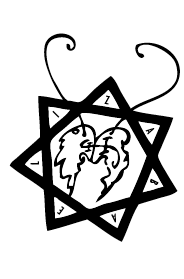

Izabael can bring love. She can make many things happen at once. She facilliates the use of other Goetic spirits so that they work harmoniously together.


Aim
Maketh one witty.
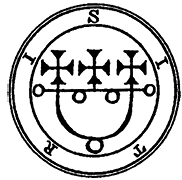

Sitri
“He inflameth a man with a woman’s love, and also stirreth up women to love men. He discloses the secrets of the opposite sex, laughing at them and mocking them, to make them luxuriously naked.”
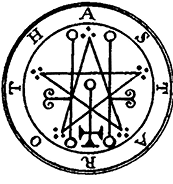

Astaroth
Makes a person wonderful learned in the liberal sciences.
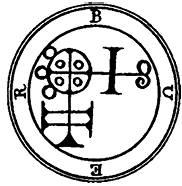

Buer
Keeps you healthy.


Eligos
Gives true advice pertaining to warfare and business. Procures the love of royalty and others of high rank.
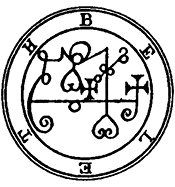

Beleth
“This great King Beleth causeth all the love that may be, both of men and of women.”
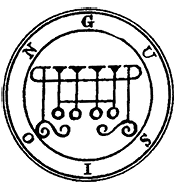

Gusion
He reconciles relationships and gives honor and dignity unto any.
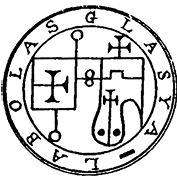

Glasya-Labolas
Teaches the art of clandestine operations, especially those requiring trickery or deceit.
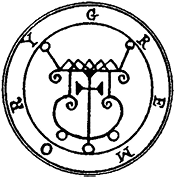

Gamori
Answers truly of things present, past, and to come, and of treasures hid, and where it lieth. She also procureth the love of women, especially of maids.


Bune
“He giveth Riches unto a Man, and maketh him Wise and Eloquent.”
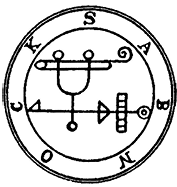

Traditionally for building high castles and well-manned turrets, today he excels at manifesting large estates and protecting them.
What’s the difference between invoking and evoking?
None as far as this book is concerned. Any time you pull a God or daemon into your consciousness, I call it invoking.
Other occult texts may make a distinction between invoking or evoking, however. Sometimes invoking means pulling a spirit into your body, while evoking just means seeing a daemon outside yourself, such as in a “magick mirror.” Other books sometimes use invocation to refer to contacting angelic forces, and evocation for summoning daemons.
Should the daemons look like the descriptions in the Goetia?
Not necessarily. In my early workings in which I would actually “see” the Goetics visually in my mind, they did sometimes look like the descriptions, but just as often they did not.
These types of visual-based visions didn’t manifest results as powerfully as later workings when I “felt” the daemons as distinct energy patterns or “essences.” On Saliva divinorum, for example, each daemon has a distinct energy signature, but doesn’t really “look” like anything other than patterns of energy. Visually, they were nothing like the descriptions in the Goetia, and yet these types of workings produced powerful material-plane results.
What if I don’t feel or see anything?
You may not have developed your astral senses enough to notice. Usually this is due to the conscious mind doubting the sensations with internal dialogue like, “That’s just my imagination. That’s not real.”
Learn to trust your imagination. Record your sensations without judgment. This will improve your subtle senses and increase the “reality” of the daemons you contact.
The previous ritual, and especially the long conjurations, are designed to put you in a mild altered state of consciousness, but the chanting, ceremony, symbolism, and incense may not quite be enough for some people. If all else fails, you may need to connect with the spirits in more intensely altered states of consciousness. In that case, you may experiment with mind-altering drugs, fasting, self-flagellation, etc. All these are advanced methods, however, and you are better off sticking with the meditations and rituals given in this book and allowing your astral senses to open gradually.
Another way of invoking is to deliberately call the daemon into your dreams. In this case, perform the ritual before bed, and state explicitly to the daemon that you wish to have an appearance during a dream. Do this every night until it happens. This works best if you are a person who naturally remembers your dreams or has lucid dreams. More details on dreaming are discussed the next chapter.
Daemons and Entheogens
An entheogen, which means “creates god within,” is a psychoactive substance used in a magickal, shamanistic, religious, or spiritual context.
Daemons and entheogens do mix for many magicians so there is no sense avoiding this subject, especially since I myself have done more than my share of dabbling.
Marijuana or small amounts of alcohol may help make a connection with a daemon, especially if you don’t normally drink or smoke.
Hallucinogens such as Psilocybin mushrooms, Salvia divinorum, Peyote, Ayahuasca, and LSD can be mind blowing when mixed with ceremonial magick, especially demonology.
While it would be remiss of me not to mention that entheogens can work well in magick, I should also mention I don’t believe they are necessary. They can also be detrimental if used as a crutch, instead of a stepping stone. If the entheogens of your choice are illegal in your jurisdiction, then that is another problem facing you if you decide to use them.
If you do use them, simply use them in context of the ritual given in this chapter. In the case of short-acting entheogens such as Salvia divinorum, you can take a puff just after your invocations and then note your sensations.138
Daemonic Results
Ultimately it doesn’t matter what a daemon looks like, says, or does, or even how intensely it materializes. If your real life shows improvement or otherwise manifests the changes you are looking for, that is all that matters.
The converse is true too. The detailed and vivid appearance of a daemon isn’t of much use if it never manifests any sort of change upon the material plane. The entire point of using daemons is to affect the physical world.
What if a daemon promises me things but doesn’t deliver?
Sometimes people make solid astral contact with a daemon and it readily agrees to everything the magician wants, but then weeks, months, and longer go by with no discernable results. Why is this so?
Sometimes a real connection to the daemon is not made, and it’s merely a mental fabrication—but mental fabrications often lead to the real thing, so perhaps you just need to try another working, or be more patient for the results.
Sometimes the daemon is unable to fulfill your request for one reason or another, and a follow-up conjuration is needed to find out exactly why. Perhaps, the daemon is not a good match for you or your desire.
Also, some daemons are deceitful. Not all daemons in the Goetia are created equal, and other grimoires have a completely different style and personality. No one really knows where all these daemons came from, and some are more likely to deceive than others.
Ultimately, if a particular daemon isn’t working for you, then move onto another, or drop demonology completely.
As popular as demonology is, I want to make clear it is not necessary to work with daemons to be a successful magician. In fact, you may very well end up a better magician without ever working with them at all.
Exercise 8: Daemon Invocation
Use the ritual given in this chapter to invoke Izabael or some other daemon of your choice. This is entirely optional.
114 . Hesiod, Homeric Hymns, Epic Cycle, Homerica. Translated by Evelyn-White, H G. Loeb Classical Library Volume 57. Cambridge, MA, Harvard University Press; London, William Heinemann Ltd. 1914.
115 . Known as a kõan.
116 . Albert Einstein, “Science, Philosophy and Religion: a Symposium,” 1941.
117 . Also the motto for its official publication the Equinox.
118 . The Book of the Law, II. 30.
119 . From the Arabic (jinni).
120 . You can find full versions of most of these online if you simply Google their titles.
121 . Pronounced a variety of ways, none of which is particularly definitive in any authoritative sense, including go-AY-shuh, GO-eht-ee, and GO-shuh.
122 . Also called The Lemegeton, or The Lesser Key of Solomon the King.
123 . Steganographia (c.1499; published Frankfurt, 1606) is superficially about spirits and how to send messages over long distances. In actuality, it is about how to hide messages so that no one except the intended recipient knows it’s there. This book rightly lends its name to the entire field of steganography, but its use as a grimoire is dubious.
124 . “Arbatel of the magic of the ancient.”
125 . This isn’t an actual grimoire like the others, but rather a system gleaned from the journals of John Dee and Edward Kelley.
126 . The translation by S. L. Mac Gregor Mathers is called The Book Of Sacred Magic Of Abramelin The Mage.
127 . This process is said to take a year and a half, though the popular Mather’s translation, considered less scholarly than the newer Dehn and Guth translation, says only six months.
128 . Thelemic magicians often refer to their female sex magick partners as Babalon, in the tradition of Crowley.
129 . For example, her name of seven letters adds to 56 by Gematria, which is also the number of Nuit.
130 . An attempt to list these would be difficult, as they are either so personal that they are embarrassing or so typical of poltergeist phenomena that they would sound cheesy. Nothing was so extreme as in movies, but things moving, or appearing in odd places was known to happen. If this scares you, it shouldn’t. It’s been rare even for me, and the more likely problem is that your early contact with daemons will be too weak rather than too strong.
131 . The oracle was irritated because she thought Izabael was doing strange things around her house like putting an odd-looking insect in her noodles. She also did not last much longer as Izabael’s priestess. This was the last such working we performed.
132 . Editor’s Note: Proceed at your own risk.
133 Liber LXXXIV can easily be found by Googling online, within which you can find the temple
openings for Fire, Water, and Earth as well.
134 . Ancient Egyptian god of wind and air.
135 . Based on the traditional conjurations in the Goetia. You may add other conjurations from the Goetia at your discretion, but you might want to omit the adversarial ones that come last, especially with Izabael. There is simply no need to take that tone with her. Better to repeat the earlier conjurations, or simply the one given here, over and over until she manifests.
136 . Any small digital recorder is good for this. You may keep one specifically for daemonic workings that you use for no other purpose.
137 . Try Googling “Goetia.pdf” for example.
138 . Google my free e-book So You Want to be a Goetic Shaman? for more details on this.